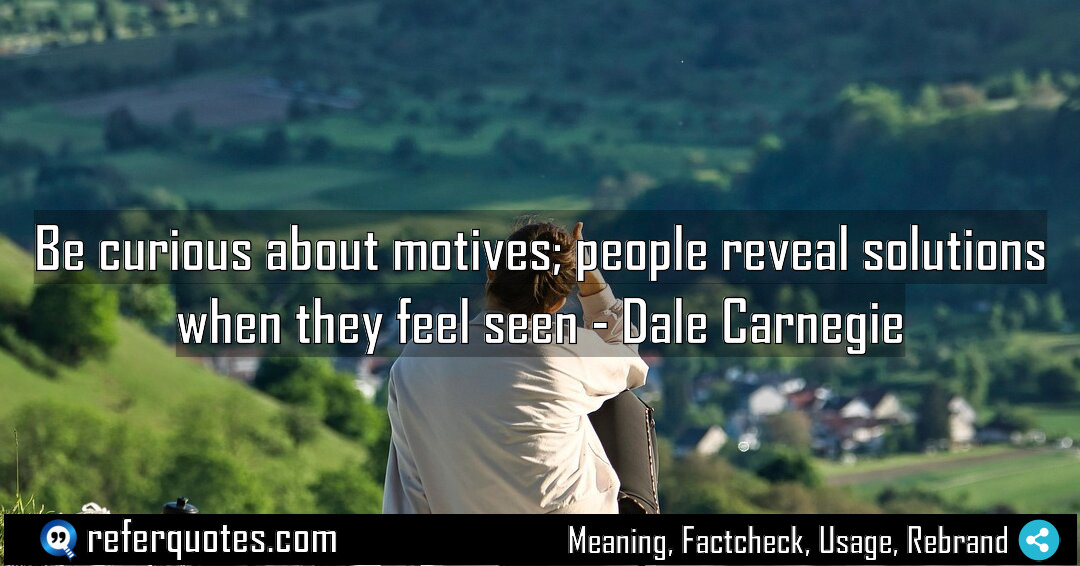
You know, that idea to “Be curious about motives” is a game-changer. It’s about unlocking solutions by making people feel truly heard. When you focus on their ‘why’, the ‘how’ to fix things just appears.
Share Image Quote:
Table of Contents
Meaning
At its core, this is about shifting your focus from the problem a person is presenting to the person having the problem. The solution is often hidden within their motivation.
Explanation
Let me break this down from my own experience. We’re all trained to jump straight to the solution, right? Someone has an issue, and we start firing off answers. But that’s a trap. What this quote teaches is to pause. Get genuinely curious. Why are they acting this way? What’s the real goal behind their frustration? When you ask those questions, you’re not just solving a surface-level issue. You’re validating them. You’re making them feel seen. And here’s the magic part—when people feel understood, their defenses drop. They stop arguing for their position and start collaborating on a path forward. They literally hand you the key. It’s a subtle but incredibly powerful psychological shift.
Quote Summary
Reading Level38
Aesthetic Score60
Origin & Factcheck
This wisdom comes straight from the playbook of Dale Carnegie Training, specifically from their 2009 book, The 5 Essential People Skills. It’s important to note this isn’t a direct quote from Dale Carnegie himself, who passed away decades earlier, but it’s a principle deeply rooted in his famous teachings from How to Win Friends and Influence People. You’ll sometimes see similar sentiments misattributed to other communication gurus, but the core idea is pure Carnegie methodology.
Attribution Summary
Author Bio
Dale Carnegie(1888), an American writer received worldwide recognition for his influential books on relationship, leadership, and public speaking. His books and courses focus on human relations, and self confidence as the foundation for success. Among his timeless classics, the Dale Carnegie book list includes How to Win Friends and Influence People is the most influential which inspires millions even today for professional growth.
Official Website |Facebook | X | Instagram | YouTube |
Where is this quotation located?
| Quotation | Be curious about motives; people reveal solutions when they feel seen |
| Book Details | Publication Year/Date: 2008
ISBN/Unique Identifier: 9781416595489 (ISBN-13), 1416595487 (ISBN-10)
Last edition. Number of pages: Common reprints ~256 pages |
| Where is it? | Chapter 22 Understanding Interests, Unverified – Edition 2008, page range ~263–272 |
Context
In the book, this isn’t just a feel-good tip. It’s presented as a critical strategy for resolving conflicts. The chapter frames this curiosity as a form of assertiveness—not aggression, but a confident way to de-escalate tension and get to the heart of a disagreement without creating more resistance.
Usage Examples
So how does this work in the real world? Let me give you a couple of scenarios I’ve seen firsthand.
For a Manager: An employee is consistently missing deadlines. Instead of saying, “You need to be more punctual,” you’d ask, “I’ve noticed the deadlines have been a struggle lately. Help me understand what’s going on with your current workload?” You’re curious about the motive (overwhelmed? unclear priorities?), and the solution (delegation, better tools, clearer expectations) will emerge from that conversation.
For a Salesperson: A prospect keeps objecting to the price. Instead of just defending the cost, get curious. “I understand the budget is a concern. To make sure I’m bringing you the right value, what other solutions are you comparing this to?” Their motive might be they don’t see the unique ROI, and their answer reveals exactly what you need to highlight to close the deal.
For a Parent: A child is throwing a tantrum about homework. Instead of yelling “Just do it!”, you try, “You seem really upset about this math sheet. What part of it is making you so frustrated right now?” The motive is avoidance of failure, and the solution is help with that specific problem, not the homework as a whole.
To whom it appeals?
Share This Quote Image & Motivate
Motivation Score54
Popularity Score62
Shareability Score46
FAQ
Question: How is this different from just being nosy?
Answer: Great question. It’s all about intent. Nosiness is for your own gossipy benefit. This kind of curiosity is empathetic and focused on helping *them*. Your tone and genuine desire to understand make all the difference.
Question: What if someone doesn’t want to share their motives?
Answer: That’s common. You can’t force it. The goal is to create a safe enough space that they *feel* they can. Sometimes, just demonstrating that you’re asking—that you care about the ‘why’—is enough to build trust over time, even if they don’t open up immediately.
Question: Isn’t this just manipulation?
Answer: Only if your goal is selfish. If your true goal is a mutually beneficial outcome and a stronger relationship, it’s the opposite of manipulation. It’s authentic connection. Manipulation is about tricking someone for your gain; this is about understanding someone for a shared win.
Similar Quotes
Appeal to the nobler motives… it’s a game-changer. This isn’t about manipulation; it’s about connecting with the best version of someone to get things done. Table of Contents Meaning Explanation…
Those who lead with purpose never have to convince others because their authenticity is magnetic. It’s not about slick sales pitches; it’s about radiating a ‘why’ so compelling that people…
To motivate people, connect the task to what matters. It’s the secret sauce for getting anyone to truly care about the work. You’re not just assigning a task; you’re illuminating…
You know, I’ve seen it time and again: Express genuine interest in people and watch cooperation appear. It’s the single most powerful lever for turning conflict into collaboration. Table of…
When we are clear about our why, we stop chasing and start attracting. It’s like a magnetic force for the right people, opportunities, and energy. You’re not just building a…
